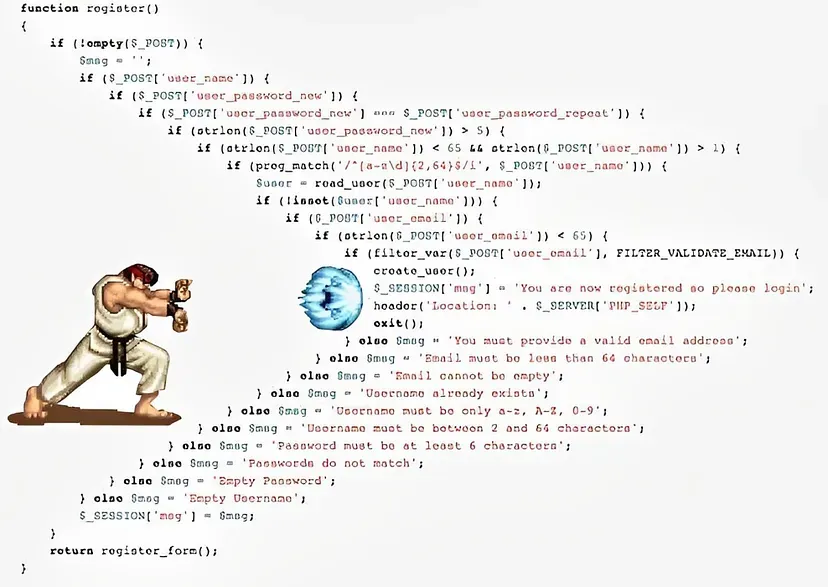尽管if-else语句随处可见,但如果过度使用,可能会导致代码复杂且难以维护。在本文中,我们将探索各种策略来减少Java Spring Boot项目中if-else结构的使用,重点关注如何使代码更加模块化、可维护和易读。
 图片
图片
“厄运之塔”或“波动拳代码”
减少If-Else语句的策略
- 策略模式
- 枚举的使用
- 多态
- Lambda表达式和函数式接口
- 命令模式
- Guard子句
让我们逐一深入探讨这些策略,并给出示例。
1. 策略模式
策略模式定义了一系列算法,封装了每一个算法,并使它们可以互相替换。当你有多种方式来执行某个特定任务时,这种模式就很有用。
示例:支付处理系统
首先,定义一个PaymentStrategy接口:
public interface PaymentStrategy {
void pay(double amount);
}接下来,实现不同的支付策略:
@Component
public class CreditCardPayment implements PaymentStrategy {
@Override
public void pay(double amount) {
// 信用卡支付处理逻辑
System.out.println("Paid " + amount + " using Credit Card.");
}
}
@Component
public class PaypalPayment implements PaymentStrategy {
@Override
public void pay(double amount) {
// PayPal支付处理逻辑
System.out.println("Paid " + amount + " using PayPal.");
}
}创建一个使用该策略的PaymentService:
@Service
public class PaymentService {
private final Map<String, PaymentStrategy> paymentStrategies = new HashMap<>();
public PaymentService(List<PaymentStrategy> strategies) {
for (PaymentStrategy strategy : strategies) {
paymentStrategies.put(strategy.getClass().getSimpleName(), strategy);
}
}
public void processPayment(String strategyName, double amount) {
PaymentStrategy strategy = paymentStrategies.get(strategyName);
if (strategy != null) {
strategy.pay(amount);
} else {
throw new IllegalArgumentException("No such payment strategy: " + strategyName);
}
}
}2. 枚举的使用
枚举可用于表示一组预定义的常量及其相关行为。
示例:订单状态管理
定义一个OrderStatus枚举并赋予不同的行为:
public enum OrderStatus {
NEW {
@Override
public void handle() {
System.out.println("Processing new order.");
}
},
SHIPPED {
@Override
public void handle() {
System.out.println("Order shipped.");
}
},
DELIVERED {
@Override
public void handle() {
System.out.println("Order delivered.");
}
};
public abstract void handle();
}在服务中使用这个枚举:
@Service
public class OrderService {
public void processOrder(OrderStatus status) {
status.handle();
}
}3. 多态
多态允许对象被视为其父类的实例,而不是其实际类。这使你能够通过父类的引用调用派生类的重写方法。
示例:通知系统
定义一个Notification接口及其实现:
public interface Notification {
void send(String message);
}
public class EmailNotification implements Notification {
@Override
public void send(String message) {
// 发送电子邮件的逻辑
System.out.println("Sending email: " + message);
}
}
public class SmsNotification implements Notification {
@Override
public void send(String message) {
// 发送短信的逻辑
System.out.println("Sending SMS: " + message);
}
}创建一个使用多态的服务:
@Service
public class NotificationService {
private final List<Notification> notifications;
public NotificationService(List<Notification> notifications) {
this.notifications = notifications;
}
public void notifyAll(String message) {
for (Notification notification : notifications) {
notification.send(message);
}
}
}4. Lambda表达式和函数式接口
Lambda表达式可以简化你的代码,特别是在处理小型、单方法接口时。
示例:折扣服务
定义一个使用Lambda表达式的折扣服务:
import java.util.HashMap;
import java.util.Map;
import java.util.function.Function;
public class DiscountService {
private Map<String, Function<Double, Double>> discountStrategies = new HashMap<>();
public DiscountService() {
discountStrategies.put("SUMMER_SALE", price -> price * 0.9);
discountStrategies.put("WINTER_SALE", price -> price * 0.8);
}
public double applyDiscount(String discountCode, double price) {
return discountStrategies.getOrDefault(discountCode, Function.identity()).apply(price);
}
}5. 命令模式
命令模式将请求封装为一个对象,从而允许你使用队列、请求和操作对客户端进行参数化。
示例:文件操作
定义命令接口及其具体实现:
public interface Command {
void execute();
}
public class OpenFileCommand implements Command {
private FileSystemReceiver fileSystem;
public OpenFileCommand(FileSystemReceiver fs) {
this.fileSystem = fs;
}
@Override
public void execute() {
this.fileSystem.openFile();
}
}
public class CloseFileCommand implements Command {
private FileSystemReceiver fileSystem;
public CloseFileCommand(FileSystemReceiver fs) {
this.fileSystem = fs;
}
@Override
public void execute() {
this.fileSystem.closeFile();
}
}定义FileSystemReceiver和Invoker:
public interface FileSystemReceiver {
void openFile();
void closeFile();
}
public class UnixFileSystemReceiver implements FileSystemReceiver {
@Override
public void openFile() {
System.out.println("Opening file in Unix OS");
}
@Override
public void closeFile() {
System.out.println("Closing file in Unix OS");
}
}
public class FileInvoker {
private Command command;
public FileInvoker(Command cmd) {
this.command = cmd;
}
public void execute() {
this.command.execute();
}
}6. Guard子句
Guard子句提供了一种提前处理条件的方式,通过尽早处理无效条件,使你的代码更加易读,并减少嵌套结构。
示例:用户验证
在这里不嵌套if-else语句来验证用户输入,而是使用Guard子句来提前处理无效情况:
public class UserService {
public void registerUser(User user) {
if (user == null) {
throw new IllegalArgumentException("User cannot be null");
}
if (user.getName() == null || user.getName().isEmpty()) {
throw new IllegalArgumentException("User name cannot be empty");
}
if (user.getEmail() == null || user.getEmail().isEmpty()) {
throw new IllegalArgumentException("User email cannot be empty");
}
// Proceed with registration
System.out.println("Registering user: " + user.getName());
}
}这种方法可确保及早处理无效条件,并使主要逻辑保持简洁易懂。
结论
通过应用这些策略,你可以大大减少在Java Spring Boot项目中使用if-else语句。这不仅使你的代码更可读,也提高了其可维护性和可扩展性。采用这些模式和实践来编写更简洁、更高效的代码吧。

































